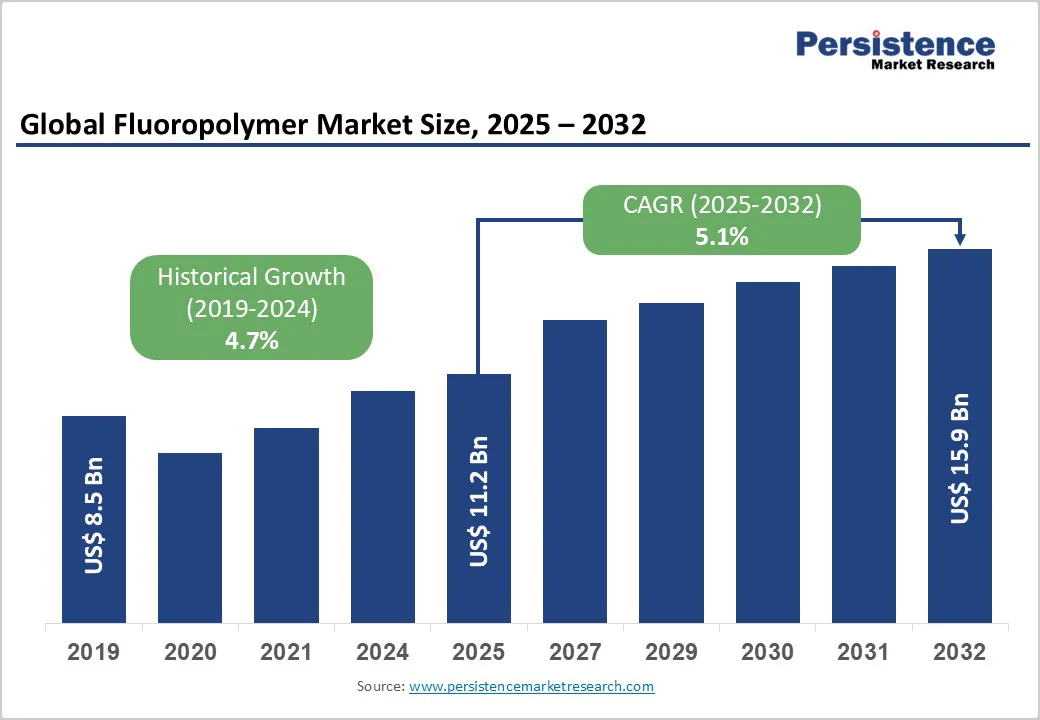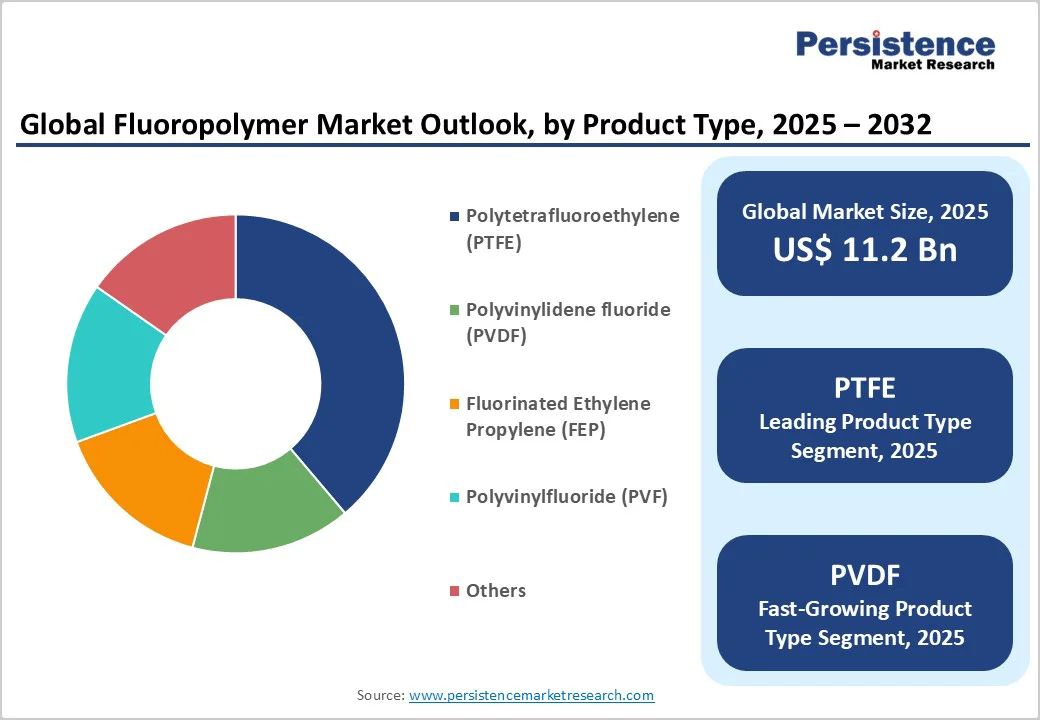ID: PMRREP2610| 190 Pages | 4 Nov 2025 | Format: PDF, Excel, PPT* | Chemicals and Materials

The global fluoropolymer market size is likely to value at US$ 11.2 billion in 2025 and is projected to reach US$ 15.9 billion by 2032, growing at a CAGR of 5.1% from 2025 to 2032.
The market growth is primarily driven by the rising adoption of fluoropolymers in industrial equipment and electronics applications, owing to their exceptional chemical resistance, excellent thermal stability, and superior electrical insulation properties.
The growing transition to electric vehicles and stricter regulations on energy efficiency are further accelerating market penetration.
| Key Insights | Details |
|---|---|
| Fluoropolymer Market Size (2025E) | US$ 11.2 Bn |
| Projected Market Value (2032F) | US$ 15.9 Bn |
| Global Market Growth Rate (CAGR 2025 to 2032) | 5.1% |
| Historical Market Growth Rate (CAGR 2019 to 2024) | 4.7% |

The rapid proliferation of electric vehicles (EVs) and the expansion of the advanced electronics sector are major factors fueling market demand. As automakers pursue higher voltage architectures and improved thermal management, fluoropolymer-insulated harnesses deliver essential safety and reliability benefits.
For instance, leading EV manufacturers such as Tesla have shifted toward high-performance wiring solutions in their latest models, amplifying the use of PVDF and ETFE in battery enclosures, sensors, and critical wire insulation.
Innovations in the Acrylates Copolymer Market have further enhanced compatibility and performance profiles of fluoropolymers, directly benefiting the segment. The need for resilient, high-purity materials in semiconductor manufacturing and 5G infrastructure is driving additional growth in demand for fluoropolymer tubing, seals, and films.
Regulatory bodies across North America, Europe, and the Asia Pacific are strengthening norms related to volatile organic compound (VOC) emissions and product lifecycle sustainability. Fluoropolymer-based coatings and membranes are increasingly adopted for their ability to extend product service life, reduce maintenance cycles, and comply with green building certification frameworks such as LEED.
As energy and industrial companies emphasize operational reliability and climate resilience, durable fluoropolymer linings are mainstreaming in critical chemical, water, and power sectors. This regulatory momentum is vital in driving structural demand shifts in construction, infrastructure upgrades, and industrial asset management.
Ongoing scrutiny and evolving restrictions on Per- and Polyfluoroalkyl Substances (PFAS), particularly under the EU REACH framework and local U.S. regulations, pose significant uncertainty for the fluoropolymer value chain.
Although fluoropolymers are often exempted for critical uses due to their low extractability and unique properties, the compliance burden and potential for regional bans are resulting in project delays and higher qualification costs for end-users. Major OEMs are also recalibrating supply networks to prioritize certified and environmentally compliant materials, thereby increasing operational challenges for market participants.
The dominance of a few countries, especially China, in the mining and supply of fluorspar and other key raw materials remains a tactical risk. Fluorspar supply constraints and energy-intensive manufacturing processes have exposed processors and converters to price spikes and production disruptions.
Smaller and non-integrated manufacturers, reliant on merchant hydrofluoric acid and commodity intermediates, face more acute cost pressures, occasionally resulting in production curtailments or delayed deliveries in high-growth end-use segments.
The global push for renewables, including solar and wind energy installations, has opened new and rapidly growing avenues for fluoropolymer use. In solar modules, PVF-PVF laminates exhibit approximately 30% improved weather resistance compared to legacy backsheet materials, enhancing performance and operational lifespan in utility-scale installations.
Similarly, wind turbine generators are increasingly equipped with fluoropolymer-insulated systems to optimize dielectric strength under high-moisture exposure, a trend mirrored in the emerging hydrogen economy, where fluoropolymer-lined electrolyzer systems are expected to command close to 60% share by 2027. This surge in application breadth is anticipated to significantly elevate market revenues in the coming years.
Leading manufacturers are investing aggressively in sustainable production routes, including bio-based monomers and advanced pyrolysis-based PTFE recycling solutions. As environmental regulations in end-use verticals become stricter, the ability of fluoropolymer manufacturers to provide low-impact, sustainably engineered grades will be a definitive advantage.
The evolution of recycling protocols and adoption of circular economy frameworks are driving demand for recycled content and innovative business models, with forward-thinking suppliers increasingly securing multi-year offtake agreements with downstream processors.
PTFE holds an unrivaled leadership position, accounting for approximately 60% market share in 2025. Its superior chemical inertness, broad operating temperature envelope (–200°C to +260°C), and legacy installation base make it indispensable in gaskets, pump linings, diaphragms, and non-stick coatings.
Innovations in high-purity PTFE and derivative products for semiconductor and pharmaceutical processing have further expanded value-added use cases. Environmental regulations have spurred ongoing product development, particularly in relation to the Acrylates Copolymer Market, enhancing cross-segment integration.
In 2025, films are expected to claim the leading application due to their unique attributes, such as exceptional chemical resistance, electrical insulation, and dimensional stability. The rising usage across semiconductors, medical devices, and renewable energy applications are key factors accelerating fluoropolymer films demand.
Their deployment in solar modules, aerospace, and advanced battery packaging ensures critical barrier performance and longevity. Growing demand for high-durability packaging and advanced filtration systems in pharmaceuticals and food processing are further bolstering this segment’s growth.
Industrial equipment is the anticipate to hold nearly 40% share of the global market, underpinned by chemical processing, oil & gas, and advanced manufacturing applications. The unique combination of PTFE, FEP, and PVDF as linings, gaskets, and components ensures equipment withstands aggressive chemicals, ensuring minimal downtime and long service intervals.
The stability and reliability delivered by these materials support their entrenched specification in process industries even as emerging applications in electronics and battery manufacturing amplify future uptake.

North America, accounting for 22% of the global Fluoropolymer Market in 2025, is supported by a strong innovation ecosystem and a proactive regulatory framework that promotes the adoption of low-emission materials and high-performance solutions.
The United States leads regional growth, supported by substantial investments in next-generation semiconductor fabrication facilities and a thriving aerospace industry. Recent VOC regulation updates have accelerated the shift toward fluoropolymer-based coatings and architectural membranes, particularly in California, where emission standards are more stringent.
Integrated supply chains, underpinned by robust domestic resin production and rapid R&D cycles, enable quick scaling of advanced grades for electric vehicles, aerospace, and defense applications. Strategic collaborations between major chemical producers and component manufacturers continue to drive innovation and ensure supply resilience across the region.
Europe, holding a 27% share of the global Fluoropolymer Market in 2025, is anchored by key growth hubs such as Germany, the U.K., France, and Spain, supported by their well-established automotive, electronics, and chemical industries.
The region’s growth is further propelled by regulatory harmonization under the EU Green Deal and the evolving REACH framework, which have accelerated the shift toward environmentally friendly fluoropolymer formulations, especially in EV batteries and green hydrogen infrastructure.
Germany continues to lead regional advancement through strategic investments in supply chain sustainability and performance validation, with a focus on next-generation PTFE and PVDF coatings. Additionally, OEMs and system integrators across Europe are increasingly pursuing cross-industry collaborations aimed at enhancing material resilience and expanding the adoption of fluoropolymers in both traditional industrial sectors and emerging high-tech applications.
Asia Pacific is expected to lead the global fluoropolymer market with a 42% share in 2025, is projected to experience the fastest growth through 2032, driven primarily by China, Japan, and India. The region’s expansion is fueled by the aggressive development of new semiconductor fabrication facilities in Taiwan and South Korea and the rapid electrification of transportation networks in China and India.
Strong government support, combined with cost-competitive manufacturing ecosystems, provides significant scale advantages, while robust public and private R&D investments continue to spur innovation in advanced polymer technologies. Furthermore, the surging demand for fluoropolymer intermediates in solar panels, batteries, and water purification systems firmly establishes the Asia Pacific as the core growth engine of the global fluoropolymer industry.

The global fluoropolymer market is moderately consolidated, with competition primarily driven by technology leadership, secure raw material supply, and adherence to stringent regulatory standards. Companies possessing captive fluorspar mines or integrated production chains demonstrate greater resilience to price volatility and supply disruptions, providing a strategic advantage over less integrated competitors.
Leading manufacturers are actively pursuing alliances and partnerships focused on capacity augmentation, sustainable product development, and recycling technologies, ensuring both innovation and operational efficiency. Rising emphasis on environmentally friendly fluoropolymers, compliance with VOC and REACH standards, and energy-efficient production are becoming core differentiators, especially in North America and Europe.
The global fluoropolymer market is projected to reach US$ 15.9 billion by 2032, growing from US$ 11.2 billion in 2025.
Key demand drivers include rising adoption in electric vehicles, advanced electronics, clean energy systems, and increased sustainability focus in industry.
Polytetrafluoroethylene (PTFE) is the leading product type, commanding roughly 60% share in 2025.
Asia Pacific is the leading region, with China, Japan, and India central to demand and capacity expansion.
Surging use of fluoropolymers in renewable energy and green hydrogen applications represents a pivotal growth opportunity.
Key players include The Chemours Company, Daikin Industries, and 3M, among others, all notable for their innovation and global scale.
| Report Attribute | Details |
|---|---|
| Forecast Period | 2025 to 2032 |
| Historical Data | 2019 to 2024 |
| Market Analysis | US$ Billion for Value Tons for Volume |
| Key Regions Covered |
|
| Key Market Segments Covered |
|
| Key Companies Profiled in the Report |
|
| Report Coverage |
|
By Product Type
By Application
By End-use
By Region
Delivery Timelines
For more information on this report and its delivery timelines please get in touch with our sales team.
About Author